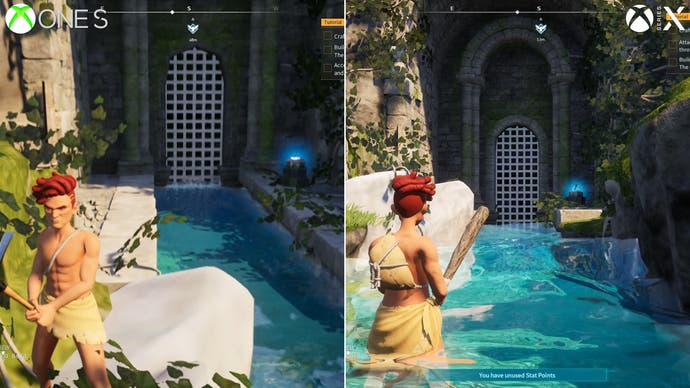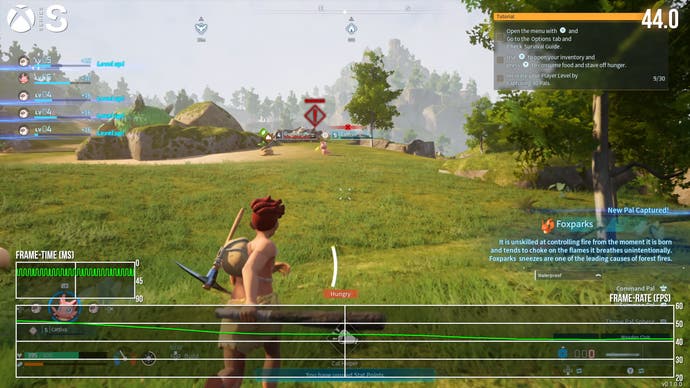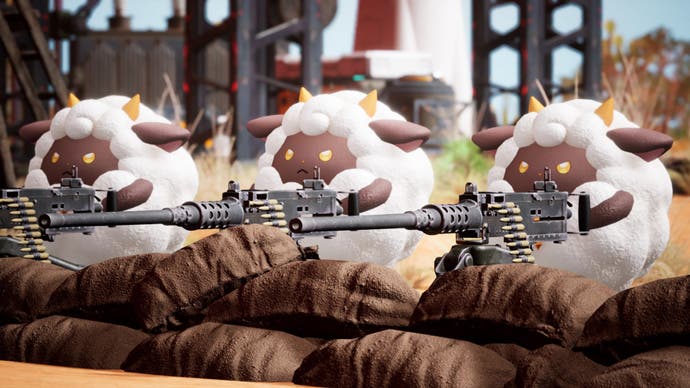Palworld's performance troubles on Series X/S are doubled on Xbox One/One X
It's out now on early access - but clearly there's a lot of work to do.
As well as being a breakout hit on Steam, Palworld is available to play on both PC and Xbox systems via a preview build on Game Pass. As well as the expected Series X and Series S compatibility, this Unreal Engine 5 release is intriguing in that Xbox One consoles are also supported.
In summary, developer Pocket Pair blended the survival aspects of games like Ark: Survival Evolved with the open world monster hunting of Pokémon. Specifically, it takes Pokémon Legends: Arceus from 2022 as its main point of reference, with a similar range of seamless exploration, capturing and battling creatures. And yes, it's this similarity to Pokémon that has clearly been a topic of some controversy given so many of its ideas - and creatures - bear more than a passing resemblance to Game Freak's own designs.
Beyond the controversy though, just how does the game look and run on Xbox Series X, Series S, Xbox One X and (the 10+ years old) base Xbox One? How close are they to hitting their target 60fps, given the frame-rate is unlocked on all four? And how do Palworld's visuals scale from the most powerful machine to the weakest? Let's just say that early access has never been so apt a description. From a technical perspective, there's a lot of work to do before the game can be considered final.
Before we get into the frame-rate tests, a quick word on the tech fundamentals. Despite being an open world UE5 game, Palworld somehow fits into a small 6GB install - or just 5GB on the base Xbox One machines. Also, despite the huge success it's having on PC, it's worth stressing once again that this is most definitely in an early access state, a preview build, with plenty of bugs.
Most bugs are related to collision detection, clipping and animation. You'll see Pokémon and NPCs get stuck in the world's geometry, jittering on the spot as they try to escape an eternity trapped in place. You'll see creatures floating midair, and even Pals rocketing into space for no reason at all. Also, while the world is easy on the eye, with a similar aesthetic to Breath of the Wild - complete with rag doll physics and a cloud simulation effect - there are definite rough spots. Even on Series X, we're stuck with muddy low resolution textures at points that fail to swap to a higher-grade asset. There's aggressive pop-in on geometry too.
A more serious problem is stability - the game is quite prone to crashes as of patch 0.1.1.0, and after only eight hours of testing, every Xbox has abruptly closed the game executable at some stage. There's no error mesage; we have to go back to the Xbox dashboard and start the game all over again.

With that in mind, let's run through the Xbox consoles from most powerful to least. Starting with the Series X, we're gunning for a 60fps frame-rate with v-sync, so there's no screen tearing on show. Broadly speaking though, the game simply isn't optimised well enough to lock to 60fps right now on Series X, with a 40-50fps readout being most common. You can only really get that 60fps update by looking straight up at the sky. Given the game's relatively basic graphical feature set at present, you'd certainly hope big improvements are on their way once the game leaves early access.
The native resolution also bears mention. Series X runs at a fixed 2880x1620, rather than using the dynamic resolution scaling we often see in Unreal Engine titles. DRS would allow the game to run more smoothly, pulling back resolution to buck up performance in the most GPU-heavy scenes. Given the open world action and often chaotic battles, this kind of flexibility is badly needed and ought to be added as a quick fix for performance before more time-intensive optimisations are considered, even if it does result in some visual degradation. Similarly, an option for a capped 30fps would at least deliver a smoother experience without the wild frame-rate swings of the game as it stands.
Ideally, the solution to poor Palworld performance on Series X in the long run will involve smarter optimisations in terms of LOD management. Judging by the state of the game as it stands, with obvious geometry pop-in and often low-quality shadows and textures, there's clearly a lot of work to be done. The game does at least spring for pretty screen-space reflections on Series X, which is actually kept on every Xbox platform.
Moving over to Xbox Series S next, there are a few surprises. First, the frame-rate is significantly better than on Series X, with the opening area running at 50-60fps while larger-scale areas still dipping into the 30s on occasion but holding a higher average frame-rate than the Series S. Given that we're more typically between 40-60fps, anyone using a VRR display will get some joy out of the unlocked 60fps output of the machine. Simply put then, Series S is the best performing Xbox machine of the quartet.
As you might expect though, the reason for the frame-rate advantage on weaker hardware does come down to visual sacrifices, including a significant drop in resolution. We're at a fixed 1280x720, while textures and shadows are a match for Series X - even at their ugliest points. While we get SSR into the bargain, there is a noticeable drop in draw distances for geometry. There's more pop-in on Series S for buildings too. Combine that with the lower image quality, it does take a sacrifice to get closer to - and sometimes hit - that target 60fps.
There's also Xbox One X support and bearing in mind the 6TF machine sports a more powerful GPU than Series S but a weaker CPU, it's perhaps unsurprising that the turnout for Palworld shows a mixture of fortunes. On the plus side, One X is able to render at a higher (and still fixed) 1080p resolution. This gives us a marked upgrade in image quality over the 720p on Series S.

Performance is also quite good in those initial scenes where you're putting together your first workbench, with 50-60fps readouts commonplace. Sadly, One X has very clear drawbacks visually. As we descend to the lower plains, it's clear that texture resolution - at its very worst - is of much lower quality and a significant downgrade from Series S. Likewise, draw distance settings are lower for geometry, trees, and grass tufts all round.
That leads us on to problem number two: the overall frame-rate. Despite the promising start at 50-60fps, entering more complex open areas drags us well into the 20s for prolonged spells. That's a level of performance I've not yet seen on Series X or Series S. At worst, I measured just 17fps in spots with lots of roaming Pals. There's a big issue with asset streaming hitches on One X too - most likely down to CPU contention or reliance on a mechanical hard drive for storage. Any interaction with the menus, or even simply running across busy areas, triggers a big frame-time spike which disrupts the already low frame-rate reading.
All of which brings us to the base Xbox One - or rather the One S I used in my tests. In a nutshell, all the visual cutbacks on the One X apply once again with lowered grass and geometry LODs, significantly pared back texture quality and lower grass density. The resolution drops further too, to just 960x540 - while the frame-rate is only just salvageable at between 15-35fps. Most of the early sections hover at around the 35fps mark, in fairness, but once you embark into the first open field area, it's practically on par with One X's worst readout, well into the 20s and as low as 16fps in the same trouble spot as before. In the event that you're curious about Palworld, you've clung onto your trusty Xbox One and don't mind stumping up for a Game Pass subscription then, be braced for a great many cutbacks - plus the traversal and menu hitches that blight the Xbox One X too.

Of course, it's not surprising that an early access and open world title from a small development team doesn't scale particularly gracefully from Series X to One S - that's a huge gulf in CPU, GPU and storage horsepower that even veteran developers sometimes struggle to address properly. However, if the developers do want to target these machines for the game's eventual 1.0 release, then significant optimisation steps are required to pare down the relatively acceptable Xbox Series X/S versions to suit these weaker machines, given that the One machines are already lumbered with significant visual cutbacks beyond resolution.
More generally, Palworld is a fascinating exercise in copy-cat development. There's a lot of direct borrowing going on - from Pokémon Legends: Arceus and Ark: Survival Evolved to The Legend Zelda: Breath of the Wild. To an extent, mimicking another game's mechanics is expected in an industry that thrives off of imitation and iteration - the string of Souls-likes that arrived since 2010 speaks to that. At times, imitation helps to move the needle forward and hone a bold new idea in unexpected directions. However, the extent to which developer Pocket Pair has created a likeness of so many Pokémon designs is an issue that's already raised Nintendo's interest.
That aside, the game's shock success does prove one thing: there is a demand for a Pokémon-style game on PC. A next-gen Pokémon, if you like, built on more advanced tech with a networked multiplayer element. For all its blatant borrowing, it'll be interesting to see how Palworld's fusion of ideas evolves beyond this early access state.








.jpg?width=291&height=164&fit=crop&quality=80&format=jpg&auto=webp)







